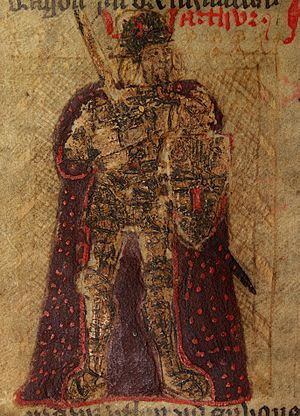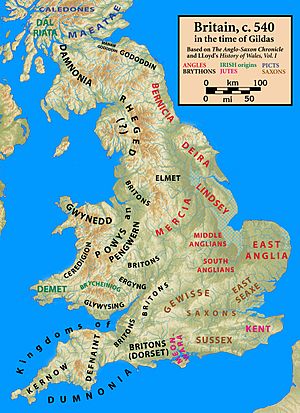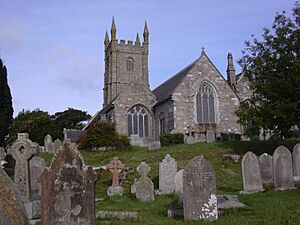Constantine (Briton) facts for kids
Constantine (/ˈkɒnstəntiːn/, Welsh: Cystennin) was a king who lived in the 500s in a part of Britain called Dumnonia. This area is now known as Cornwall and Devon in Southwest England. Later stories remember him as a legendary King of Britain, even linked to King Arthur.
We know about Constantine from a writer named Gildas, who lived at the same time. Gildas wrote about Constantine's actions, including the killing of two young princes inside a church. Constantine is also mentioned in the family trees of the Dumnonian kings. He might have even inspired the stories of Saint Constantine, a king who became a monk.
Hundreds of years later, in the 1100s, a writer named Geoffrey of Monmouth included Constantine in his famous book, Historia Regum Britanniae. Geoffrey added details to Gildas's account. He also made Constantine the king who took over after King Arthur. Because of Geoffrey's book, Constantine often appears as Arthur's heir in many later stories and legends.
Contents
History of King Constantine
The monk Gildas wrote about Constantine in his book De Excidio et Conquestu Britanniae. Gildas criticized five British kings, comparing them to wild animals. He called Constantine the "tyrannical whelp of the unclean lioness of Damnonia." This "Damnonia" is usually thought to be the kingdom of Dumnonia in Southwest Britain.
Gildas wrote that Constantine had sworn an oath to be honest and fair. But he broke this oath. Constantine dressed up in a priest's robes and attacked two young princes who were praying in a church. He killed them and their friends. Gildas said Constantine had done many other wrong things before this. Gildas hoped Constantine, who was still alive, would change his ways. Some think these murders might be linked to a story in Brittany about two young princes killed by their uncle.
Experts believe that Gildas's Constantine is the same person as Custennin Gorneu or Custennin Corneu. This name means "Constantine of Cornwall." He appears in the family trees of the kings of Dumnonia. These old records say Custennin was the father of Erbin and the grandfather of the hero Geraint. Based on these family trees, historians think Constantine lived around 520–523 AD.
Saint Constantine: King to Monk
The real King Constantine of Dumnonia might have inspired later stories about a Saint Constantine. These stories are found in Southwest Britain, Wales, Ireland, and Scotland. They usually say that Saint Constantine was a king who gave up his crown to become a monk. People in Cornwall and Wales might have believed Gildas's criticism worked. They thought Constantine truly repented and became a holy man.
Two main places where Saint Constantine was honored were churches in Constantine Parish and St Merryn Parish (now Constantine Bay) in Cornwall. The church in Constantine Parish was built by the 1000s. It is mentioned in an old book called Life of Saint David. The chapel at Constantine Bay had a holy well, which was a special place for people.
Old records like the Annales Cambriae (Welsh Annals) and the Annals of Ulster mention a Constantine who converted to a religious life. This might be the Cornish saint and the historical king. Other religious texts also mention Constantine, often saying he was the King of Cornwall. The Life of Saint David says Constantine, King of Cornwall, gave up his throne to join Saint David's monastery. Another story, Vitae Petroci, tells how Saint Petroc protected a deer from a rich man named Constantine. This Constantine later became a monk. A 12th-century text says this Constantine was a king. He gave Petroc an ivory horn, which became a special holy item. Many other stories across Britain mention saints or kings named Constantine. This suggests different figures might have been mixed up over time.
Other places in Southwest Britain linked to people named Constantine include churches in Milton Abbot, Devon, and Illogan, Cornwall. Some of these might have been dedicated to Constantine the Great, a famous Roman Emperor. In Wales, two churches were named after Constantine: Llangystennin and Welsh Bicknor. A church in Govan, Scotland, was also dedicated to a Saint Constantine.
Geoffrey of Monmouth and King Arthur
Geoffrey's Historia Regum Britanniae

Geoffrey of Monmouth included Constantine in his book Historia Regum Britanniae. He changed Gildas's story quite a bit. In Geoffrey's version, the kings Gildas criticized become Arthur's successors, not his enemies. Geoffrey also used the Dumnonian family trees. He added new details, saying Constantine was the son of Cador, a ruler from Cornwall.
Most importantly, Geoffrey made Constantine a relative of King Arthur. He said Constantine took over as King of the Britons after Arthur was badly wounded. Some historians think Geoffrey made this connection because Arthur was sometimes linked to Southwest Britain. Others believe Geoffrey just invented this link. He had already connected Arthur to other famous Constantines. Geoffrey called Constantine Arthur's "blood relative," but he didn't say exactly how they were related. This caused confusion for later writers.
In Geoffrey's story, Arthur gives his crown to Constantine after being hurt in the Battle of Camlann. This battle was against the traitor Mordred. Geoffrey says Gildas's "royal youths" were actually Mordred's two sons. These sons, with their Saxon allies, continued their father's rebellion after Mordred died. Constantine fought many battles and defeated the rebels. Mordred's sons ran away and hid in a church and a friary. Constantine found them and killed them in these holy places.
Three years later, Constantine was killed by his nephew, Aurelius Conanus. This led to a civil war. Constantine was buried at Stonehenge with other British kings. Some experts believe Geoffrey changed Gildas's story to make Constantine seem more justified. By saying the "royal youths" were traitors, killing them was less of a crime, though still wrong for happening in a holy place. Overall, Geoffrey's story shows that Arthur's great kingdom didn't last long after his death.
Later Stories and Chronicles
Geoffrey wrote more about Constantine's struggles in another book, Vita Merlini. This book said Constantine gave Mordred's sons a "cruel death" and ended their rebellion. It didn't mention the details of the killing. The Vita says Constantine ruled only a short time before Conanus killed him and took the throne. This book also suggests that Constantine couldn't keep Arthur's kingdom as glorious as it had been.
Many later books copied Geoffrey's version of Constantine. These books were very popular in the Middle Ages. They include Wace's Roman de Brut, the Welsh Brut y Brenhinedd, and Layamon's English Brut. These stories usually showed Constantine in a similar way to Geoffrey. Layamon, however, added a bit of hope. He wrote that Constantine did a good job, even if for a short time, in ruling like Arthur wanted. Many of these books didn't explain Constantine's exact relation to Arthur. But some said he was Arthur's nephew. They often made Constantine's father, Cador, a brother or half-brother of Arthur through Arthur's mother, Igraine.
Constantine in Later Legends
Medieval Romances and Prose
Constantine doesn't appear much in the famous Arthurian romance stories. In some popular French stories, Lancelot and his family kill Mordred's sons. No one takes over as king after Arthur. Some experts think this was done to make Mordred's takeover seem more serious. It also made Lancelot's role in the story bigger. Not having an heir also made Arthur's story feel more final after his death.
However, Constantine does show up in some medieval works. In a 14th-century book, Lancelot helps Constantine become king after Arthur dies. He is also king of Britain in some versions of the Havelok the Dane legend. This started with a 12th-century book called Estoire des Engleis. Constantine is also mentioned as Arthur's successor in a 14th-century English poem, the Alliterative Morte Arthure. Other English romances that mention Constantine include The Awntyrs off Arthure and Sir Gawain and the Carle of Carlisle.
In a 16th-century Portuguese novel, Constantine is combined with the famous Round Table knight Sagramore. This new character, "Sagramor Constantino," is Arthur's son-in-law and heir. As king, he creates a new Round Table to continue Arthur's glory. Constantine's relation to Arthur changes a lot in these later stories. Many don't say how they're related. Others follow the older chronicles, making him Arthur's nephew. Some English stories even make him Arthur's grand-nephew.
Constantine also appears as Arthur's heir in Thomas Malory's Le Morte d'Arthur. Malory made some changes to his sources to give Constantine a bigger role. Malory wrote that Arthur named Constantine and Baldwin of Britain as temporary rulers before Arthur went to fight the Romans. In the original poem, Mordred had this role. Malory also expanded Constantine's role after Arthur's death. He said Constantine ruled honorably and brought back the Bishop of Canterbury. Experts say this makes Malory's book end on a more hopeful note. It suggests that Arthur's ideals continued under Constantine's rule.
Modern Stories and Media
Constantine appears in some modern versions of the Arthurian legend.
- Katrina Trask's 1892 book, Under King Constantine, is a collection of poems set during his reign.
- He is an important character in Henry Newbolt's 1895 play Mordred, where he is Arthur's successor.
- In Rosemary Sutcliff's 1963 novel Sword at Sunset, the wounded "Artos" (Arthur) willingly gives the crown to Constantine.
- In Parke Godwin's 1984 novel Beloved Exile, Constantine is one of several nobles fighting Guenevere to become Arthur's successor.
- He is the main character in the 1990 computer game Spirit of Excalibur. Players control Constantine and his friends as they protect the kingdom after Arthur's death.
- Darrell Schweitzer's 1995 fantasy story "The Epilogue of the Sword" features an older Lancelot helping Constantine fight the Saxons.
- Constantine is a big part of Arthur Phillips' 2011 novel The Tragedy of Arthur. This book is about a fake Arthurian play supposedly written by William Shakespeare. In the play, Constantine is Guenhera's brother and Arthur's helper and heir.
- In Lucy Holland's 2021 novel, Sistersong, Constantine is the son of Cador, King of Dumnonia. He has two sisters, Riva and Sinne. Constantine is born as Keyne and is a trans man. He is guided by the wizard Myrdhin/Mori. His kingdom is threatened by Gildas, who is a Roman priest and magician in this story, and by the Saxons. Constantine meets Gwen when her people escape the Saxons. They fall in love and likely marry and rule together. In the end, Constantine leaves his throne and travels with Myrdhin/Mori.



